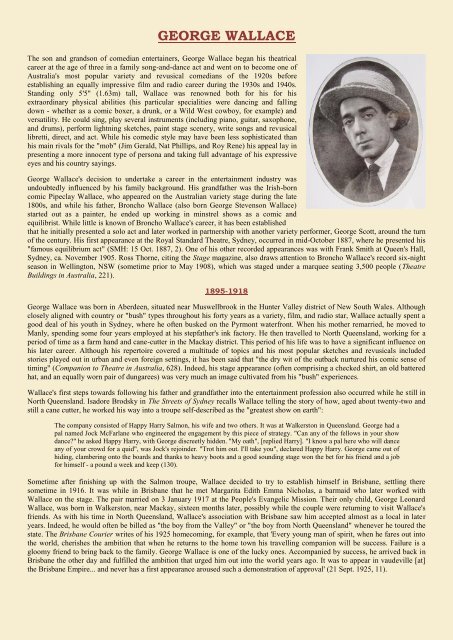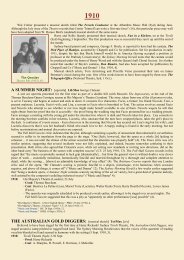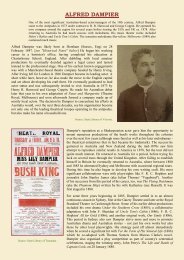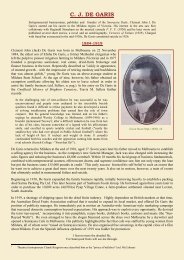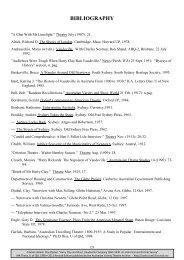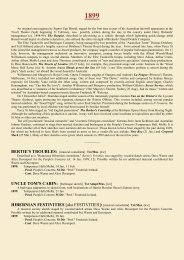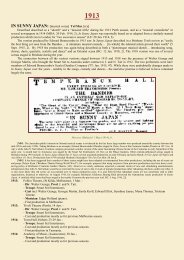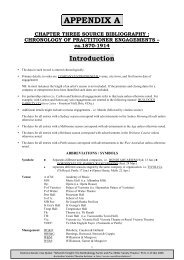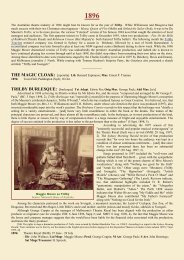GEORGE WALLACE - Australian Variety Theatre Archive
GEORGE WALLACE - Australian Variety Theatre Archive
GEORGE WALLACE - Australian Variety Theatre Archive
Create successful ePaper yourself
Turn your PDF publications into a flip-book with our unique Google optimized e-Paper software.
<strong>GEORGE</strong> <strong>WALLACE</strong><br />
The son and grandson of comedian entertainers, George Wallace began his theatrical<br />
career at the age of three in a family song-and-dance act and went on to become one of<br />
Australia's most popular variety and revusical comedians of the 1920s before<br />
establishing an equally impressive film and radio career during the 1930s and 1940s.<br />
Standing only 5'5" (1.63m) tall, Wallace was renowned both for his for his<br />
extraordinary physical abilities (his particular specialities were dancing and falling<br />
down - whether as a comic boxer, a drunk, or a Wild West cowboy, for example) and<br />
versatility. He could sing, play several instruments (including piano, guitar, saxophone,<br />
and drums), perform lightning sketches, paint stage scenery, write songs and revusical<br />
libretti, direct, and act. While his comedic style may have been less sophisticated than<br />
his main rivals for the "mob" (Jim Gerald, Nat Phillips, and Roy Rene) his appeal lay in<br />
presenting a more innocent type of persona and taking full advantage of his expressive<br />
eyes and his country sayings.<br />
George Wallace's decision to undertake a career in the entertainment industry was<br />
undoubtedly influenced by his family background. His grandfather was the Irish-born<br />
comic Pipeclay Wallace, who appeared on the <strong>Australian</strong> variety stage during the late<br />
1800s, and while his father, Broncho Wallace (also born George Stevenson Wallace)<br />
started out as a painter, he ended up working in minstrel shows as a comic and<br />
equilibrist. While little is known of Broncho Wallace's career, it has been established<br />
that he initially presented a solo act and later worked in partnership with another variety performer, George Scott, around the turn<br />
of the century. His first appearance at the Royal Standard <strong>Theatre</strong>, Sydney, occurred in mid-October 1887, where he presented his<br />
"famous equilibrium act" (SMH: 15 Oct. 1887, 2). One of his other recorded appearances was with Frank Smith at Queen's Hall,<br />
Sydney, ca. November 1905. Ross Thorne, citing the Stage magazine, also draws attention to Broncho Wallace's record six-night<br />
season in Wellington, NSW (sometime prior to May 1908), which was staged under a marquee seating 3,500 people (<strong>Theatre</strong><br />
Buildings in Australia, 221).<br />
1895-1918<br />
George Wallace was born in Aberdeen, situated near Muswellbrook in the Hunter Valley district of New South Wales. Although<br />
closely aligned with country or "bush" types throughout his forty years as a variety, film, and radio star, Wallace actually spent a<br />
good deal of his youth in Sydney, where he often busked on the Pyrmont waterfront. When his mother remarried, he moved to<br />
Manly, spending some four years employed at his stepfather's ink factory. He then travelled to North Queensland, working for a<br />
period of time as a farm hand and cane-cutter in the Mackay district. This period of his life was to have a significant influence on<br />
his later career. Although his repertoire covered a multitude of topics and his most popular sketches and revusicals included<br />
stories played out in urban and even foreign settings, it has been said that "the dry wit of the outback nurtured his comic sense of<br />
timing" (Companion to <strong>Theatre</strong> in Australia, 628). Indeed, his stage appearance (often comprising a checked shirt, an old battered<br />
hat, and an equally worn pair of dungarees) was very much an image cultivated from his "bush" experiences.<br />
Wallace's first steps towards following his father and grandfather into the entertainment profession also occurred while he still in<br />
North Queensland. Isadore Brodsky in The Streets of Sydney recalls Wallace telling the story of how, aged about twenty-two and<br />
still a cane cutter, he worked his way into a troupe self-described as the "greatest show on earth":<br />
The company consisted of Happy Harry Salmon, his wife and two others. It was at Walkerston in Queensland. George had a<br />
pal named Jock McFarlane who engineered the engagement by this piece of strategy. "Can any of the fellows in your show<br />
dance?" he asked Happy Harry, with George discreetly hidden. "My oath", [replied Harry]. "I know a pal here who will dance<br />
any of your crowd for a quid", was Jock's rejoinder. "Trot him out. I'll take you", declared Happy Harry. George came out of<br />
hiding, clambering onto the boards and thanks to heavy boots and a good sounding stage won the bet for his friend and a job<br />
for himself - a pound a week and keep (130).<br />
Sometime after finishing up with the Salmon troupe, Wallace decided to try to establish himself in Brisbane, settling there<br />
sometime in 1916. It was while in Brisbane that he met Margarita Edith Emma Nicholas, a barmaid who later worked with<br />
Wallace on the stage. The pair married on 3 January 1917 at the People's Evangelic Mission. Their only child, George Leonard<br />
Wallace, was born in Walkerston, near Mackay, sixteen months later, possibly while the couple were returning to visit Wallace's<br />
friends. As with his time in North Queensland, Wallace's association with Brisbane saw him accepted almost as a local in later<br />
years. Indeed, he would often be billed as "the boy from the Valley" or "the boy from North Queensland" whenever he toured the<br />
state. The Brisbane Courier writes of his 1925 homecoming, for example, that 'Every young man of spirit, when he fares out into<br />
the world, cherishes the ambition that when he returns to the home town his travelling companion will be success. Failure is a<br />
gloomy friend to bring back to the family. George Wallace is one of the lucky ones. Accompanied by success, he arrived back in<br />
Brisbane the other day and fulfilled the ambition that urged him out into the world years ago. It was to appear in vaudeville [at]<br />
the Brisbane Empire... and never has a first appearance aroused such a demonstration of approval' (21 Sept. 1925, 11).
1919-1923<br />
After having developed a solo and double act (with his wife) that he believed had potential, Wallace decided in late 1918 to move<br />
to Sydney to take advantage of the work opportunities that the city's much expanded industry had to offer. Shortly after his arrival,<br />
he was given a start on Harry Clay's suburban circuit, having impressed the management with his acrobatic clog-dancing. His<br />
initial salary was £4 a week. Brodie Mack, for many years the Fullers' booking agent, recalls the comedian's arrival in Sydney: 'I<br />
happened to be at Harry Clay's Newtown Bridge <strong>Theatre</strong> (it's now The Hub) looking for new acts. It was his trial appearance, and<br />
he was appearing for nothing. He stopped the show. His acrobatic dance had them rolling in the aisles. Harry wasn't in the theatre<br />
to see it; he asked me afterwards how the new man went. "Don't let him get away," I replied. "You have a real comedian there"<br />
(SMH: 23 Oct. 1960, 57).<br />
Wallace quickly became a crowd favourite as a solo performer. The husband/wife act struggled somewhat during the first few<br />
months, however, with several reviews from early 1919 indicating that the act had limited appeal. An <strong>Australian</strong> <strong>Variety</strong> critic, for<br />
example, simply says, "The Two Wallaces - very inexperienced, bad routine and mixed up turn" (24 Jan. 1919, n. pag.). However,<br />
the <strong>Theatre</strong> critic found things on the improve a few months later, writing:<br />
Princess <strong>Theatre</strong>, 8-15th March: George Wallace is a comedian with a delightfully quiet style. He gets his laughs without any<br />
forcing. His wife helps him in the patter. They wind up by introducing their son, a tiny mite, in one clever acrobatic pose<br />
(Apr. 1919, p.28).<br />
Although the double act did not last much longer under the close scrutiny of Harry Clay's management, Wee Georgie Wallace<br />
continued to made semi-regular appearances on the stage with his dad over the next five or so years, including feature spots with<br />
Dinks and Oncus.<br />
As with many of Clay's other contracted performers, Wallace often appeared in revusicals, with these being presented as the<br />
second half of an entertainment bill at most of his venues. The one-act musical comedy was the most popular of all the variety<br />
theatre genres being staged in Australia during that era, and a number of Clay's leading artists had, since 1915, been given the task<br />
of writing and staging their own productions. This experience provided Wallace with the necessary training to eventually become<br />
one of Australia's most popular revusical practitioners. One of the earliest productions he appeared in, A Fireman's Troubles by<br />
Joe Rox, led the <strong>Theatre</strong> magazine to write of Wallace's performance that "George Wallace is a comedian with a delightfully quiet<br />
style. He gets his laughs without any forcing... Chief honours are annexed by Wallace in a clever Johnny study and by Billy Cass<br />
and Joe Rox as two impossible firemen" (Apr. 1919, 28).<br />
Dinks and Oncus<br />
<strong>Australian</strong> Women's Weekly 30 June (1971), 13.<br />
His value as a performer even during these early days on the Clay circuit was due<br />
in part to his versatility, an aspect that factored largely in his success throughout<br />
his career. In June 1919, for example, the <strong>Theatre</strong> described Wallace's "clever<br />
clog-dancing as... reminiscent of the days of Dan Tracey" (25). By the end of the<br />
year, the same magazine said of his act that "His female impersonations have the<br />
house in shrieks all the time he's on the stage" (Jan. 1920, 26). Wallace was also<br />
beginning to attract the attention of <strong>Australian</strong> <strong>Variety</strong>, which records in<br />
December that "[He] is gaining applause for his smart dancing and good comic<br />
songs [and] since his opening... has made rapid strides towards success" (11 Dec.<br />
1919, n. pag.).<br />
A little over a year after joining Harry Clay's organisation, George Wallace's<br />
career reached new heights when he joined forces with comedian Jack "Dinks"<br />
Paterson to form Dinks and Oncus, an act that Katherine Brisbane notes had no<br />
equal in being so well remembered purely from appearances on Clay's circuit<br />
(179). In an interview conducted shortly after Wallace's death in 1960, Paterson<br />
recalls how the partnership started: "It began in the park opposite the old Opera<br />
House (now the Tivoli). George and I, both of us under contract to Harry Clay's<br />
suburban vaudeville circuit, were watching the crowds pack in to see Stiffy and<br />
Mo when George said suddenly, 'There's the opportunity for us. Why don't we<br />
team up and become a double act, too?' We finally got the old man to give us a try.<br />
George and I never looked back'" (SMH: 23 Oct. 1960, 57).<br />
[For details regarding George Wallace's career between 1920 and 1923 see the Dinks and Oncus entry]<br />
1924-1928<br />
George Wallace is believed to have left Harry Clay's management not long after he and Jack Paterson ended their Dinks and<br />
Oncus partnership in late 1923. He was subsequently offered a contract by the Fullers sometime around January 1924. Ben A.<br />
Fuller, son of Sir Benjamin, recalls the night his father sent him to the Bridge <strong>Theatre</strong> to ascertain Wallace's prospects as a<br />
possible Fullers' comedian:<br />
We needed a show in a hurry for Dunedin [New Zealand]. My father told me, "I think that young fellow Wallace out at<br />
Newtown would go over for us. Go and have a look at him tonight." It was a Monday night but the theatre was packed - that's<br />
how popular George was. I sat in the centre stalls with Brodie Mack, when suddenly part of the stage went up in flames. One
of the cloths caught alight, too. Panic was imminent. The place was wooden. People started to scream and leave their seats. I<br />
don't mind admitting I was terrified. But they rang down the act "drop" to block off the flames, and a little man came out in<br />
front. - George Wallace. George wasn't a bit concerned. He said it was "only a little fire, somebody was mucking about." He<br />
told jokes, calmed the audience and called the others back to their seats. They put out the fire and the show went on. He was a<br />
real trooper (SMH: 23 Oct. 1960, 57).<br />
According to Fuller, Wallace was duly signed for the Dunedin season but there were concerns over how he would fare in New<br />
Zealand, the fear being that he was too much of a dinki-di Aussie to go over with the Kiwis: "But we were wrong," he recalls.<br />
The Dunedin people made him their idol. They wouldn't let him go. He stayed six months and did eight shows three times<br />
over. We were amazed. ... George was also a fine black and white artist. When the Dunedin show went on for so long the<br />
company ran out of scenery so we'd ship George the sewn canvas backdrops and he painted the scenery himself. To my<br />
knowledge he never cracked a blue joke in his life. He had a thing about smut on the stage. Never in 15 years with us was he<br />
reprimanded for saying anything off colour (SMH: 23 Oct. 1960, 57).<br />
In mid-1924, Wallace and his newly formed revusical company played its first-ever<br />
<strong>Australian</strong> engagement at the Majestic <strong>Theatre</strong>, Newtown (August - October). The troupe<br />
went on to tour the Fullers' <strong>Australian</strong> and New Zealand circuits through to the end of the<br />
1920s, establishing a reputation rivalled only by the companies led by Stiffy and Mo and<br />
Jim Gerald. Although hugely popular throughout the Antipodes, Wallace's stronghold of<br />
support was undoubtedly Queensland. Reporting on the comedian's return to Brisbane in<br />
1925, for example, the Brisbane Courier records that he had given the city its brightest star<br />
of recent years. "As clever as Tom Dawson was,' suggested the paper's critic, he 'could not<br />
provoke more smiles a minute than this Valley-born boy" (12 Oct. 1925, 16). In reviewing<br />
the same production the <strong>Theatre</strong> magazine went so far as to ask:<br />
Is it flying in the face of theatrical providence to prophesy that George Wallace will<br />
one day be Australia's greatest comedian? In a little revue last month entitled<br />
Harmony Row, this Newtown favourite put over one of the best comedy performances<br />
Fullers' <strong>Theatre</strong> has ever seen. And this includes the ever-green favourites Stiffy and<br />
Mo, who may well look to their laurels now that George Wallace has come to town.<br />
[He] has immense personality... [and] a delicious sense of humour". Although the<br />
review notes that Wallace still lacked "sufficiently wide experience," and hence his<br />
style of humour was still somewhat nondescript (and thus not distinct enough to be<br />
imitated), the critic indicated that it was obviously only a matter of time before he<br />
found his own niche: "Remember these words, and watch', concluded the critic (Apr.<br />
1925, 15).<br />
Almost every industry critic appears to have agreed from at least 1925 that he was a major <strong>Australian</strong> comedian in the making,<br />
however, with an Everyone's scribe disagreeing wholeheartedly with the <strong>Theatre</strong>'s assessment: "[He] is decidedly individualistic,<br />
for his style is particularly his own," he or she writes (11 Mar. 1925, 34). The same magazine also drew attention in 1928 to his<br />
stature as a leading variety entertainer, pointing out that as one of the country's most versatile performers and a consistent<br />
favourite for years throughout Australia and New Zealand, Wallace also continued to write, produce, and star in his own shows.<br />
The magazine was particularly impressed with the fact that in addition to playing the saxophone, cornet, piano and drums on stage<br />
he also he sang, danced and could do an accomplished lightning sketch act (14 Nov. 1928, 41).<br />
Everyone's 15 Dec. (1926), 89.<br />
Green Room Mar. (1925), 17.<br />
[For further details of George Wallace's career between 1924 and 1930<br />
see the entry for the George Wallace Revue Company.]<br />
Everyone's 14 Nov. (1928), 41.
1929-1939<br />
By 1929, Wallace's troupe included such well-known variety performers as Jim Romaine (ex-Drew and Romaine) and husbandand-wife<br />
comedy sketch artists Bert Dudley and Evelyn Dudley. There appears to have been no reduction in interest in the<br />
company, despite the rising popularity of film. Reports indicate, for example, that their New Zealand tour of 1929 was still pulling<br />
capacity crowds fifteen weeks after it commenced. Shortly after concluding a fifteen-week season at the Melbourne Tivoli in early<br />
1930 (possibly his first non-Fullers' engagement since joining the firm in 1924), Wallace undertook a tour of the west, playing<br />
Adelaide, Perth and the West <strong>Australian</strong> goldfields through until possibly January 1931. He then travelled to England for a<br />
month's holiday before opening a season on the London variety stage, reportedly on a contract of £150 a week (E: 2 Apr. 1930,<br />
41). The shows were staged with two or three members of his <strong>Australian</strong> troupe, while the rest of the ensemble comprised<br />
performers engaged in London. However, without the support of his regular company, and with a comic delivery that may well<br />
have been too casual for the British, Wallace failed to ignite enough interest to remain there for very long. A bitterly cold winter<br />
forced his hand and he returned to Australia soon afterwards. In retrospect, it was an important decision, because the 1930s saw<br />
his career branch out successfully into film and full-scale musical comedy.<br />
Wallace's film career began in 1932, when Frank Thring signed him to Efftee Films and produce and adapt one of his most<br />
popular revusicals, His Royal Highness. Despite Thring's heavy-handed direction, the film became a critical and commercial<br />
success around the country. In reviewing the Queensland premiere, the Brisbane Courier's film critic typified the critical response<br />
to Wallace's performance:<br />
His Royal Highness is aptly described as a comedy with music as distinct from a musical comedy. The comedy is there in full<br />
measure, and although the few musical numbers introduced are tuneful they are not the essential features. The fun is almost<br />
exclusively created by George Wallace... [his] facility of expression and his whimsical drolleries, as well as clever dancing,<br />
eminently lend themselves to the screen work (3 Oct. 1932, 15).<br />
While agreeing that Wallace dominated the film (and that his comic talent was unquestioned), the Age's film critic suggested that<br />
such a dominance was part of the overall weakness of the film, as were the frequent shots in which parts of the performers' heads<br />
were lost from view (31 Oct. 1932, 8).<br />
In between his film commitments, Wallace continued to take on stage work. In 1933, for example, he accepted a cameo role in the<br />
stage musical Collits' Inn, while also contributing additional material to the libretto (including some lyrics). Although his<br />
performance as Dandy Dick was roundly applauded by audiences, at least one critic found his antics inappropriate at times and<br />
suggested that he would be more effective if he kept within his part (TBT: 28 Dec. 1933, 14). Wallace's long-time onstage partner,<br />
Marshall Crosby, was also engaged for the production (taking on the role of Pierce Collits, owner of the inn and father of the<br />
heroine, Mary). Comedian/actor John V. Dobbie, who later starred opposite Wallace in several of his films, was also in the cast.<br />
The second of Wallace's films, Harmony Row, was released in 1933, attracting similar plaudits to the first. Costing £11,000<br />
pounds, it also co-starred several members of his old revusical troupe, notably Marshall Crosby and Nell Fleming, along with<br />
well-known ex-pantomime dame Dan Thomas.<br />
Courier Mail 18 Aug. (1939), 21.<br />
In 1934, Wallace again returned to the stage, appearing as one of the<br />
principals in the Dudley Glass musical The Beloved Vagabond. Following<br />
the <strong>Australian</strong> debut in Melbourne, the Argus theatre critic wrote of<br />
Wallace's performance: "[His] Asticot is an amusing fellow - a curious<br />
blending of Australia and Montmartre, if such a fusion is comprehensible. He<br />
is adapting himself quickly and successfully to the requirements of the<br />
musical comedy stage, which is of course very difficult from the variety<br />
stage. His best number is 'Napoleon the Oneth'" (23 Apr. 1934, 12). The Age<br />
critic similarly notes the incongruous nature of Wallace's acting and the<br />
brilliance of his burlesque work in the Napoleon scene (16 Apr. 1934, 12).<br />
The Sydney season, staged later in August, saw the Sydney Morning Herald<br />
report that the comedian had never been funnier, particularly in the Paris<br />
roof-tops scene. "[It] introduced some of Mr Wallace's cleverest fooling,"<br />
wrote the paper's theatre critic. "The incident in which he represented<br />
Napoleon, with Mr John Dobbie as Wellington, was densely packed with<br />
comic ingenuity. Like Miss Moncrieff Mr Wallace has achieved greater<br />
success by being more reposeful and natural, and giving up a too obvious<br />
repertoire of stage tricks and stage inflections" (25 Aug. 1934, 16).<br />
Although Wallace continued to appear on the stage throughout the 1930s, his<br />
career during that decade is chiefly remembered for the films he starred in. A<br />
Ticket in Tatts (1934), his final Efftee production, saw him cast as a disasterprone<br />
stable hand whose whistle can make one of the horses run faster. He<br />
was slated to appear alongside Frank Harvey, Claude Fleming, and Campbell<br />
Copelin in another Thring film, Sheepmates (based on the novel by the same<br />
name, by William Hatfield), but although a few scenes were shot on a cattle<br />
station in Central Australia in late 1934, the film was never completed<br />
(Celluloid Heroes CD-Rom 1996, 1930-1939, 18).
Following F. W. Thring's death in 1936, Wallace signed with Cinesound Productions, releasing Let George Do It, the first of his<br />
two comedies with director Ken G. Hall. Co-starring Letty Craydon, Joe Valli, and Alec Kellaway, the film is memorable not only<br />
for a high-speed water chase but also for a vastly improved screen performance by its star, the result of Hall's much tighter<br />
direction (Celluloid Heroes CD-Rom 1996, 1930-1939, 43). Wallace's second film with Cinesound, Gone to the Dogs (also 1938),<br />
saw him again cast as an 'accident-prone' character, this time as a zookeeper. A review of the Brisbane premiere, which screened<br />
at the Tivoli Roof Garden, records, "It is probably the most laughable film that <strong>Australian</strong> studios have produced. The film makes<br />
no pretensions to sophistication or depth. It is clowning plus clowning plus clowning, but it is good clowning. In fact if the<br />
laughter at the world premiere can be taken as a guide, George Wallace and John Dobbie have succeeded in being more<br />
consistently funny from an <strong>Australian</strong> audience's point of view than Laurel and Hardy, who probably are more famous"<br />
(BC: 21 Aug. 1939, 4). Both films made a profit for Cinesound and were released in England, with Wallace generally garnering<br />
positive reviews for his performances.<br />
1940-1960<br />
When not required in a film production Wallace continued to tour his live shows, mostly on the<br />
Tivoli circuit. During World War Two, he briefly teamed up with English singer/comedian<br />
Jenny Howard, possibly the first time he'd partnered a woman in a comic duo since his first<br />
wife. Then at the height of her fame, Howard was brought back to Australia for a ten-week tour<br />
by Tivoli director Wallace Parnell (she had first toured the country back in the 1920s).<br />
Howard's appeal is said to have been the result of her ability to switch back and forwards from<br />
sentimental songs to broad farce, with both performance styles managing to bring tears to eyes<br />
of many a patron. Touring under the title The Crazy Show, Wallace and Howard headlined a<br />
troupe that also included Bob Dyer and Gloria Dawn (then aged only twelve). It was during the<br />
war, too, that he wrote his most famous and best-remembered song, "A Brown Slouch Hat."<br />
According to Billy Maloney, the song earned him more than £1,500 in royalties "in the days<br />
when APRA [<strong>Australian</strong> Performing Rights Association] were not half so active as they are<br />
today" (41).<br />
Jenny Howard<br />
*<br />
Wallace's two final films saw him take on supporting roles, including as a barber in The Rats of<br />
Tobruk (1944) and the small role of a flustered stage manager in Wherever She Goes (1951), a film<br />
biography about celebrated <strong>Australian</strong> pianist Eileen Joyce. According to Billy Maloney, there had<br />
been talk in the 1930s of the comedian being offered a Hollywood contract. His failure in England in<br />
the late 1920s may have instilled in him the realisation that he was far too <strong>Australian</strong> to appeal to<br />
foreign tastes, leading him to decline all offers (39).<br />
The late 1940s saw Wallace's third significant career path open up, this time in radio. In 1949, he<br />
presented the George Wallace Road Show on the Macquarie Network. The programme was based<br />
around a character called "Wallaby" Wallace, a local identity in the town of Bullamakanka. However,<br />
despite his considerable experience as a variety, film, and theatre actor, the move to radio was not<br />
easy for him. Jacqueline Kent cites a 1949 interview with Wallace in which he admits that he found it<br />
hard to adapt his comedic techniques to radio. "The hardest thing," said the comedian, "is keeping my<br />
voice down. After years on the stage where you have to raise your voice to make a point, I found in<br />
radio that this only made the mike blast, and it took me a long time to break the habit of wanting to shout at it" (24). Kent goes<br />
on to note that Wallace eventually emerged triumphant as a radio star, even though his shows differed from the typical<br />
programmes made by the Colgate Unit. Although still performed live in front of a studio audience, front Wallace (unlike Roy<br />
Rene) didn't have a particular set of catchphrases, and neither did the characters have any immediately recognisable characteristics<br />
(funny voices or mannerisms, etc.). "They spoke standard (though stage rural) <strong>Australian</strong>," writes Kent, "and the humour<br />
depended on fast gags rather than vaudeville-style routines. Though the humour of the Wallace shows stands up better [than most<br />
of its contemporaries] the characters did not have the same kind of familiarity as did the people living in and around [Rene's]<br />
McCackie Mansion" (24).<br />
Wallace continued to tour as a variety artist throughout the 1950s, with one notable show<br />
being Pin-up Parade (1955). Co-starring Diana Del, Barry Rugless, and Peter Madigan, it<br />
had one of its most successful seasons at Brisbane's <strong>Theatre</strong> Royal, beginning 19 March.).<br />
Among his final appearances before retiring was The Good Old Days, which toured in<br />
1957. The company comprised fellow variety veterans Jim Gerald and Queenie Paul, and<br />
emerging performers such as Maurice Colleano. In late 1958, Wallace also followed his<br />
son's twenty-two-month season at the Brisbane Tivoli <strong>Theatre</strong>, with a five-week<br />
engagement beginning 26 December. Wallace headlined a show that also included the<br />
"Queen of Striptease," Carmelita, and her fellow striptease artists, "The 6 Undraped<br />
Nudes" (for the first week of 1959, the Tivoli management advertised the programme as<br />
"George Wallace... Happy Nude Year"). The following year, Wallace finally succumbed<br />
to the heart trouble that had plagued him for several years, passing away in his sleep at his<br />
home in Doncaster Avenue, Kensington (Sydney) aged 66. He was survived by his son.<br />
_______________________<br />
* Source details are currently missing.<br />
New <strong>Theatre</strong> Australia 4 (Mar/Apr.<br />
1988), centrefold.<br />
Courier Mail 27 Dec. (1958), 6.
<strong>GEORGE</strong> <strong>WALLACE</strong>'S COMIC STYLE<br />
Though George Wallace's success was due in large part to his innate comedic abilities, the original revusicals he staged also<br />
allowed him a great deal of scope to show off his other talents. Among his more popular productions were Harmony Row and His<br />
Royal Highness (both were later adapted to film), The Pickled Porter, Alpine Antics, The Oojah Bird, Lads of the Village, Off<br />
Honolulu, and Dangerous Dan. An Everyone's review of the opening week of his return Sydney season in 1925 (this time at the<br />
Fullers' New <strong>Theatre</strong>) was one of the first to draw comparisons with Nat Phillips' shows:<br />
The popularity of that clever <strong>Australian</strong> comedian George Wallace is evidenced in the remarkable business being done here<br />
since his advent last Saturday week. Wallace is decidedly individualistic, for his style is particularly his own; moreover it is a<br />
style that meets with a remarkable amount of appreciation from local audiences... Harmony Row is this week's offering by the<br />
little comedian and it deals with the life of a policeman. The idea suggests unlimited opportunities for fun making and so it<br />
proves to be. Wallace is supported by a very fine cast which included Mr Marshall Crosby, also a ballet of very advanced<br />
order. It looks as if these tabloids will vie with the Stiffy and Mo shows in point of popularity (11 Mar. 1925, 34).<br />
Much of his humour was drawn from the simple things in life. 'He often played the hen-pecked husband whose wife berates him<br />
for his lack of responsibility', writes Katrina Bard (75). He also had an ingenious way of telling a tale, whether it be about Stanley<br />
the Bull, the Prodigal Son, the saga of Aboriginal girl Lily Quilt, and even popular favourites such as an "under the weather"<br />
husband returning home at three in the morning. In such scenes, Wallace's ability to exaggerate the falling down-drunk (often by<br />
falling down numerous times) kept audiences in stitches for years. While two of his greatest vaudeville creations were Oncus and<br />
the terribly refined bus conductress Sophie the Sort, he also invented other memorable characters such as Annie, the pride of the<br />
mob; the Drongo from the Congo; Fanny Shovelbottom's Friend; Officer Dreadnought (Harmony Row); Dangerous Dan<br />
(Dangerous Dan); Prairie Pete (At the Crossroads); Nelson, the pride of the navy (Off Honolulu); and Tommy Dodds (His Royal<br />
Highness).<br />
In Memoirs of an Abominable Showman, Billy Maloney writes of Wallace:<br />
His female creations "Sophie the Sort" and "Sophie the Busgirl" rank with another famous comedian's impersonation - Don<br />
Nicols' "Girl Guide". In recent years "Sophie" was George's most successful act, a hilarious interlude built around a<br />
passenger's attempt to take his Alsatian dog on the bus. Finally Sophie told him that the only way he could get on the bus<br />
would be to do with the dog what he told Sophie to do with the bus. It was George's nearest approach to a blue gag, but he<br />
told it with such whimsicality and finesse that it would have gone over well at a church social. Who will forget his famous<br />
description of Pavlova's "Dying Swan." "A joker rushed up a lane and shot a drake!" explained George (38).<br />
Courtesy of Jacqueline Kent Out of the Bakelite Box (1983), 25<br />
<strong>GEORGE</strong> <strong>WALLACE</strong> - THE MAN AND HIS LEGACY<br />
When George Wallace died in 1960, aged sixty-six, the Sydney Morning Herald described him as 'a scallywag (you couldn't print<br />
half the stories)' and a '100 percent <strong>Australian</strong> with a heart of gold' (23 Oct. 1960, 57). Billy Maloney says of Wallace that he was<br />
the most versatile of all his peers: 'He was a wonderful ad lib comic, he could write his own songs, he painted the scenery, did<br />
lightning sketches on stage, played piano and saxophone, was an acrobatic dancer (I'll never forget that wonderful ear-slide he did<br />
at least once every performance) and his gravel voice could easily be heard in the last row without any of your modern<br />
amplification' (38).<br />
Charles Norman provides further insights into Wallace, recalling his time with the comedian's revusical company (although he<br />
gives no indication of when this occurred): "There was one revue that George put together with a country atmosphere. We were<br />
sort of bushwhackers. There were barn dances and celebrations and songs and dances with a hillbilly twang. I think he called this<br />
little turkey Split Log Junction. This was the first show in which he put together the "little girl double act" – 'Stinker and
Sunbeam, Recitin' Singin' and Dancin'.' With the art of wearing comedy clothes his appearance was a riot before he spoke - a wig<br />
of long blond curls with an awful bow on top, and the ballet skirt, with one-up and one-down pants. With his mellow style of<br />
comedy he did what he wanted to with an audience. He was the most popular of the comedians with the American troops. In this<br />
country revue I was the one that had outgrown the town. I was commencing to look beyond the haystacks. At last the time arrived.<br />
I'm off! George wrote me a fine little song. I still have it. All the cast were on stage at the Junction (a small cut out of the end of a<br />
carriage). I was dressed in a straw hat with vivid coloured socks. Battered suitcase in one hand, I sang":<br />
I'm gonna leave this old home town of mine,<br />
I'm goin' to where the bright lights shine<br />
I wanna see a cabaret where they turn night into day<br />
I wanna see all the girls with their beautiful curls<br />
I wanna dance and sway and do the shimmy<br />
I wanna dress myself up like a lord<br />
I'm gonna buy myself a T-Model Ford<br />
And when I get back with my fortune made<br />
All the other fellers will be right in the shade.<br />
I'm gonna leave this old home town of mine!' (108-109).<br />
Numerous tributes to George Wallace's generosity and professionalism have been published over the years, with the<br />
overwhelming consensus being that he was as well liked by his industry peers as he was by his adoring public. Theatrical agent<br />
Ted James recalls his time as a second comedian working on stage with Wallace the star:<br />
He was on stage for my act and he could have easily stolen it from me, even the flick of an eyebrow would have been<br />
enough. But he didn't. He didn't even move a muscle. He just waited there, deadpan, while I got the applause and the laughs...<br />
He was a lovable bloke. Never ruthless. Perhaps he helped more struggling performers than anyone else in show business<br />
(SMH: 23 Oct. 1960, 57).<br />
In the same article, Brody Mack confirms this view of Wallace by recalling one of the comedian's many attempts to give "some<br />
deadbeat actor a part in his show":<br />
'"What can he do? What's his specialty? [I asked]." "Crowd scenes", George replied. "Good heavens", I said, "you only have<br />
20 in your company, what do you want with crowd scenes". George was quick on the comeback. "Put him with me", he<br />
winked, "and he can be the idle of the crowd" (57).<br />
By all accounts, too, Wallace was a scallywag who love to socialise and party, but was equally comfortable being alone at home,<br />
especially with his love of painting. Ted James further recalls one time in Western Australia when the company decided to have a<br />
barbeque: "George went out and barbequed statues in the park - he built fires around them" (57, 82). As one of Australia's<br />
greatest-ever comedians and vaudeville stars, George Wallace's legacy lies in his versatility, his instinctive (often ad-libbed) style<br />
of delivery, his affinity with the audiences of his day, and the amazing levels of physicality he infused into his comedy routines,<br />
an ability he shared with fellow revusical star Jim Gerald.<br />
HISTORICAL NOTES AND CORRECTIONS<br />
1. Although some publications have claimed that the Dinks and Oncus partnership was formed in 1919 (Entertaining Australia,<br />
179; Companion to <strong>Theatre</strong> in Australia, 191; and <strong>Australian</strong> Dictionary of Biography, 365), evidence from several primary<br />
sources indicates that the pair did not come together until 1920. An <strong>Australian</strong> <strong>Variety</strong> review (dated 27 May 1920) records, for<br />
example, that they had only been together a few weeks at that stage: "[George Wallace] has doubled up with Dinks Paterson, and<br />
went a riot. As they have only been together a couple of weeks, we hate to think what they will give patrons in, say, a couple of<br />
months. No bigger laugh has ever appeared on the Clay time" (8).Supporting the latter date, too, are several brief paragraphs<br />
published in the two leading industry magazines in early 1920, which appear to indicate that both men were still working solo.<br />
The <strong>Theatre</strong> (Jan. 1920, 26) reports on Wallace's female impersonation as "Annie the pride of the mob," while a report in<br />
<strong>Australian</strong> <strong>Variety</strong> the following month notes, "Dinks Paterson, who is one of the tallest members of the vaudeville profession, did<br />
a couple of new songs in the first part, and also put on a laughable sketch in the second, and which went over 'good-oh"' (12 Feb.<br />
1920, 12).<br />
The 1919 claim appears to have originally derived from the 1960 interview with Jack Paterson (SMH: 23 Oct. 1960, 57), whereby<br />
he claims that Wallace would bring his two-year-old son on stage when the act was lagging towards the end (ca. 1923). Born 16<br />
May 1918, George Leonard Wallace was actually aged five (going on six) in 1923.<br />
2. During his twenty-two-month season at Brisbane's Tivoli <strong>Theatre</strong> (9 Mar. 1957 - 24 Dec. 1958), George Wallace Jnr staged<br />
at least one of his father's revusicals: S. S. Sunshine (23-29 Mar. 1957). Due to very limited details being available through<br />
advertising and reviews, it is unclear whether he revived any others. The only George Wallace Jnr revusical/revue productions<br />
from 1957-1958 to be identified to date are Honeymoon Hotel (16-22 Mar. 1957); George Wins the Casket (13-19 Apr. 1957),<br />
possibly being based on his father's film, A Ticket in Tatts (1934); and The Follies of 1958 (4-10 Jan. 1958).<br />
3. Fred Parsons's claim that in 1929, Wallace was still "a very minor comedian, half of a comedy act called, of all things, Dinks<br />
and Oncus" (7) is an example of the type of bias and error that can be absorbed into the historical record if not checked for<br />
veracity. 1 Not only had the Paterson and Wallace partnership been dissolved for some five years by 1929, but it is also clear that<br />
1 See also the Nat Phillips/Stiffy and Mo entries for further evidence of Parsons' numerous errors and inaccuracies.
Wallace was far from being a "very minor" comic, having been a leading Fuller's act for most of the intervening years. A glance<br />
through the numerous, and mostly positive, reviews of Wallace's company during its first year or so together indicates that the<br />
comedian was even then seen as a major <strong>Australian</strong> variety performer:<br />
Courtesy of Oncus Pictures and<br />
Don Percy.<br />
George Wallace must have made a fine impression throughout New Zealand, as visitors from<br />
the dominion, when referring to Fuller shows, never fail to mention the success the little<br />
comedian made in their country, where his style of comedy was so much appreciated (E: 12<br />
Nov. 1924, 39).<br />
Fullers' <strong>Theatre</strong>:- The first appearance of the George ("Onkus") Wallace revue company at this<br />
theatre revived memories of the business done by Stiffy and Mo, inasmuch as both houses last<br />
Saturday played to capacity... As an entertainer Wallace is of the highly eccentric order, and<br />
with his extraordinary dancing and acrobatics, vies with the best revue company at present on<br />
the circuit; and this is saying something in view of some exceptionally talented performers (E: 4<br />
Mar. 1925, 30).<br />
George Wallace Jnr, five year old son of the comedian at the Fuller <strong>Theatre</strong>, was another smallsized<br />
riot at the Hippodrome last Saturday. For his years he is a mental and professional marvel.<br />
Three generations of Wallaces have now made history in <strong>Australian</strong> vaudeville, i.e. Bronco,<br />
Oncus, and now Wee George (E: 18 Mar. 1925, 36).<br />
George Wallace has immense personality. In addition, he is refined and, last but not least, has a<br />
delicious sense of humour. Only one thing he lacks; he has not yet, as it were, "found himself."<br />
At the present moment his style of humour is nondescript - his fun is spontaneous without being<br />
individual. In other words, he has not as yet had a sufficiently wide experience to adopt a brand<br />
of humour which is distinct enough to be imitated. That time has yet to come, however,<br />
remember these words and watch.... George Wallace is undoubtedly a gold mine for the Fuller<br />
firm (TT: Apr. 1925, 15).<br />
4. Wallace's half sister, Bebe Scott, appeared in his revue company around 1929-1930. In the early 1930s, she married British<br />
stage, radio, and film actor George Randall. The couple soon afterwards began what was to be a five-year engagement presenting<br />
a children's radio program, The Cap and Bebe Show, on Brisbane ABC radio station 4QG.<br />
ENGAGEMENTS CHRONOLOGY: 1919-23, 1930-1958<br />
1919: HARRY CLAY (Sydney Suburban circuit; Jan-Dec.)<br />
1920: HARRY CLAY (Sydney Suburban circuit; Jan-Dec.)<br />
1921: HARRY CLAY (Sydney Suburban circuit; Jan-Dec.)<br />
1922: HARRY CLAY (Sydney Suburban circuit; Jan-Dec.)<br />
1923: HARRY CLAY (Sydney Suburban circuit; Jan- ca. Dec.)<br />
1924: FULLERS' THEATRES (Dunedin, NZ; Feb- July*)<br />
NB: See George Wallace Revue Co for engagements details between1924 and 1930<br />
1932: FRANK NEIL (Regent Th, Bris; 22 Oct-18 Nov. > Frank Neil's Musical Comedy Revue Co).<br />
1933: F.W. THRING (Princess's Th, Melb; 23-31 Dec. > Collits' Inn).<br />
1934: F.W. THRING (Princess's Th, Melb; 1 Jan-7 Apr. > Collits' Inn) • (Princess's Th, Melb; 21 Apr-16 June > Beloved Vagabond)<br />
• New Tivoli Th, Syd; 24 Aug-10 Oct. > Beloved Vagabond).<br />
1955: (Th Royal, Bris; 19 Mar.-* > Pin-up Parade Co).<br />
1957: (Th Royal, Bris; 20 Sept- 3 Nov. > The Good Old Days Co).<br />
1958: (Th Royal, Bris; 26-31 Dec.).<br />
1959: (Th Royal, Bris; 1 Jan-5 Feb.<br />
MUSIC THEATRE WORKS<br />
1921: MULLIGAN'S MIXUP [revusical]<br />
TWO DAYS OUT [revusical]<br />
1922: IN A BALLROOM [revusical]<br />
OVER THE HILLS, TALLY HO: [revusical]<br />
1924: A DANCING DELIRIUM [revusical]<br />
SOME NIGHT [revusical]<br />
ALPINE ANTICS [revusical]<br />
THE PICKLED PORTER [revusical]<br />
OFF HONOLULU (aka S. S. SUNSHINE) [revusical]<br />
HARMONY ROW [revusical]<br />
THE OOJAH BIRD (aka HAREM SCAREM) [revusical]<br />
AT THE CROSS ROADS [revusical]<br />
LADS OF THE VILLAGE (aka THE VILLAGE LADS / BOYS OF THE VILLAGE / MR MULLIGAN,<br />
MILLIONAIRE) [revusical] Txt. George Wallace; Mus. [n/e] (1924);<br />
MIDNIGHT REVELS [revusical]
1925: DANGEROUS DAN [revusical]<br />
ATHLETIC FROLICS [revusical]<br />
MONEY AND MATRIMONY [revusical]<br />
THE SPARKLERS [revusical]<br />
1926: RISING TIDES [revusical]<br />
NIGHT LIGHTS [revusical]<br />
HAPPY MOMENTS [revusical]<br />
SCRAMBLED FUN [revusical]<br />
1927: HIS ROYAL HIGHNESS [revusical]<br />
1928: MARRIED BLISS-TERS [revusical]<br />
BALD HEADS [revusical] Txt. George Wallace; Mus. [n/e] (1928);<br />
1929: ME AND MY GIRL [revusical]<br />
S. S. SUNSHINE [revusical]<br />
1930: COLLITS' INN [musical]<br />
1933: OH WHAT A NIGHT [revusical]<br />
SONGS WRITTEN BY <strong>GEORGE</strong> <strong>WALLACE</strong><br />
The following list should be considered very incomplete. (Although years provided indicate the earliest established performance,<br />
it is likely that in many instances these songs were performed earlier)<br />
"I'm Only a Policeman" (Harmony Row, 1924);<br />
"Hula Lou" (Lads of the Village (1924);<br />
"Ethel" (The Oojah Bird 1925);<br />
"Maggie" (Midnight Revels, 1925);<br />
"The Trumpeter" (The Pickled Porter, 1925)<br />
"The Porter" (The Pickled Porter, 1925);<br />
"Sally the Slavy" (At the Crossroads (1926);<br />
"Archie and Bertie" (The Picked Porter (1928);<br />
"A Brown Slouch Hat" (1942);<br />
"There's a Boy of Mine" (1944);<br />
"Big Brother" (ca. 1945);<br />
"Roaming" (ca. 1940s);<br />
"They'll Shine Again (c 1940s).<br />
NB: George Wallace's Music and Song Annual was also published<br />
by Joe Slater in the 1940s.<br />
RECORDINGS<br />
• Stars of the <strong>Australian</strong> Stage and Radio: Volume 2. Larrikin, CD, LRH 430. [Series: Warren Faye Presents Yesterday's<br />
Australia] ("Whacko! We've Got a Date")<br />
FURTHER REFERENCE<br />
As the "Lovely Mona Lisa"<br />
<strong>Australian</strong> Women's Weekly 12 Feb. (1958), 5.<br />
"<strong>Australian</strong> Farce Rich in Laughs." BC: 21 Aug. (1939), 4. [re: Gone to the Dogs]<br />
Bard, Katrina. "History of Vaudeville in Australia - 1900-1930" (1983), 73-5.<br />
Bridges, Nancye and Frank Crook. Curtain Call. (1980), 92-6. [reproduced in Love, Harold, ed. <strong>Australian</strong> Stage Documentary (1984), 192-4]<br />
Brisbane, Katherine. Entertaining Australia: An Illustrated History (1991).<br />
Brodski, Isadore. Streets of Sydney. (1962), 130.<br />
Celluloid Heroes: The History of <strong>Australian</strong> Cinema 1895-1996. (1996). CD-Rom, various pages.<br />
Chance, Victoria. "Dinks and Oncus." CTTA: (1995), 191.<br />
"Death of George Wallace." SMH: 20 Oct. (1960), 6.<br />
Djubal, Clay. "Wallace, George." AustLit (2006).<br />
Funny by George: The George Wallace Story. (2000). [documentary]<br />
"George Wallace." <strong>Australian</strong> Screen – online (sighted 10/06/2011)<br />
"George Wallace at His Best in Fine Film Comedy." BC: 20 June (1938), 13. [re: Let George Do It]<br />
"His Royal Highness." BC: 30 Sept. (1932), 20. [see also "Regent <strong>Theatre</strong>" 1 Oct. (1932), 15]<br />
McKie, Ronald. "George Wallace: The Face of Comedy." AWW: 12 Feb. (1958), 4-5. - online (Sighted 20/08/2011)<br />
Moloney, Billy. Memoirs of an Abominable Showman. (1968), 36-41.<br />
"Oncus Rolled 'em in the Aisles." 23 Oct. (1960), 57.
Parsons, Fred. A Man Called Mo. (1973), 7.<br />
Sayers, Stuart. "Wallace, George Stephenson (1895-1960)" ADB: Vol. 12 (1988), 365.<br />
Thorne, Ross. <strong>Theatre</strong> Buildings in Australia to 1905. (1971), 221. [re: Bronco Wallace]<br />
Van Straten, Frank. Tivoli. (2003), v. pags.<br />
"When Tivoli Fans Laughed Till the Tears Ran Down Their Cheeks." AWW: 30 June (1971), 13-14.<br />
Courtesy of britishpictures.com<br />
Still from His Royal Highness (1932)<br />
Courtesy of <strong>Australian</strong> Screen<br />
Courtesy of John Reid Vintage Movie Memorabilia<br />
www.moviemem.com<br />
<strong>Australian</strong> <strong>Variety</strong> <strong>Theatre</strong> <strong>Archive</strong> • http://ozvta.com/practitioners-w/ • This page last updated: 20/08/2011<br />
First published in: Clay Djubal, "Harry Clay and Clay's Vaudeville Company" MA Thesis (1998) U of Qld (Appendix F)


